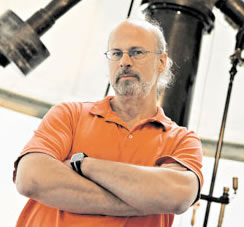"Hunter" Exoplanet Visits the DAS
Monday, August 12, 2013

The renowned American astronomer at the Carnegie Institution for Science, Paul Butler, visited the Department of Astronomy (DAS) at the Universidad de Chile where he gave on Monday August 5 seminar "Precise velocities from of R4 Iodine cell spectrometers".
Butler and his team are the main "hunters" of exoplanets, that is to say, planets found orbiting stars other than our Sun and several light years. Within their research highlights in 2002 the discovery of the body remote smallest detected so far, with a mass of only 40 times that of Earth, and the discovery of the first planetary system similar to ours with planets in circular orbits around the star 55 Cancri, after 15 years of observations.
However, in 2010 the world's eyes focused on the work of this renowned scientist after the publication of the discovery of Gliese 518 g, a planet with a mass similar to our Earth discovered in the habitable zone of its star. "The planet's orbital distance is such that liquid water could exist, and that is considered the most important ingredient for life," says Butler.
IN SEARCH OF NEW WORLDS
The search for exoplanets is relatively new in Astronomy . Butler says that "modern science began with Copernicus speculating that the Earth is a planet and that all planets revolve around the sun Then Giordano Bruno speculated that the Sun is a star like anyone, and that other stars could have planets the which could also have life. For this and other heresies , Bruno was burned at the stake in the public square in Rome in 1600 . The current findings complement the Copernican revolution , and bring us to the next level of questions: if life is common in the universe , and if there are other intelligent civilizations that communicate", he says.
Research indicates that most of the stars present in the universe have planets , which have been created from the material left over from star formation. To detect these "worlds" , we use two techniques : the transit method , which is to observe the star photometrically and detect subtle changes in the intensity of light when passing the planet in front of it , and the art of speed radial , based on the Doppler effect where the planet also exerts a gravitational force on the star it orbits , resulting in her small oscillations which generate changes in spectral lines when the star moves towards or away from us ( redshift or blue , respectively). The latter system, which has the best search results, was created by Butler and his team.
Until now , scientists have determined that small planets like Earth and Mars , are more common than giants like Jupiter , but much more difficult to detect. "It's like at the beach : there are many more grains of sand stones, but the stones are easier to find," said the expert.
Although there are still no images of exoplanets, only data that prove that they are there , Butler is optimistic. "The next generation of giant ground based telescopes, which will exist in the 2020s, and space based telescopes in the 2030s, should be able to directly image exoplanets. The real fun begins when we can take spectra of planets. If we were to detect water vapor and oxygen it would not prove there is life, but it would strongly suggest life. The argument would shift to trying explain how this might not be due to life", he says.




